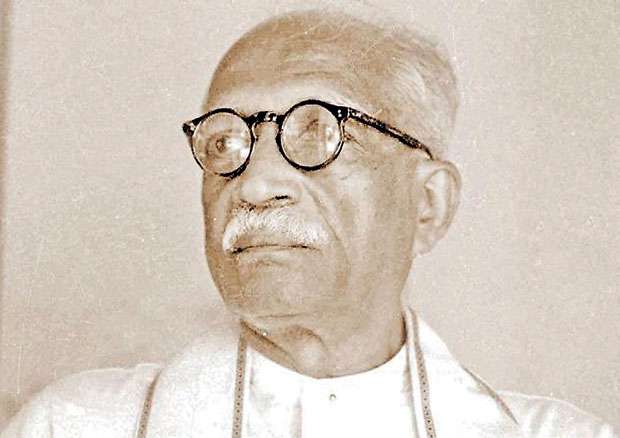18 Jan 2019 - {{hitsCtrl.values.hits}}

Indeed the cost of schooling became so prohibitive that it deterred everyone but the more affluent sections of the rural petty bourgeoisie from attending them. Besides, with the implementation of distance clauses, such schools were shut down if a missionary institution was nearby. They did not teach English properly, moreover, which in colonial society was essential in getting to the top.
Antipathy to free education stems from two broad classes, or schools of thought. The first discounts what Kannangara did on the basis that he fuelled an entire generation of chauvinists through an education system differentiated on the basis of language and ethnicity. Kannangara, however, has been vilified like Bandaranaike for all the wrong reasons here, simply because in the original proposals for free education (opposed by many in the State Council), he called for a bilingual education. In a context where less than 5% or 6% of the country spoke English, it was essential not only that Sinhala and Tamil be taught but also that education in swabasha be accompanied by education in the colonial tongue.
It’s ironic that the beneficiaries of free education themselves write against it, but they are preferable to that other school of thought which criticises Kannangara: those who believe that the colonial distinctions between “elite” and “mass” education promoted a nationalism that brought together all the ethnicities of the country. The proponents of this rather strange theory are, to be sure, a dying breed, and their argument rests on the assumption that the educationists who opposed the Kannangara proposals were moved by benign motives and that those proposals, when implemented, fermented rebellion against the elite (which, for these people, is strangely a bad thing).
In that sense, what Canon R.S. De Saram, Warden of S. Thomas’ College and a member of the National Education Committee, once said in a speech in front of Kannangara must be quoted verbatim:
... [i]t would be a pity if criticism should be allowed to degenerate into mere acrimony between those who differ on fundamental problems. Ill temper or partisanship will not solve our difficulties; nor the imposition by decree or otherwise of any one rigid system for all schools. On the contrary, toleration within limits of many varieties of educational practice is indicated by our varying conditions as the right and wise policy.
Note the hostility to any attempt made by the State to impose a uniform standard for all schools. If this argument can be considered valid, it can also be discounted by the simple fact that the State, i.e. the colonial government, had already implemented such a standard, for the vernacular and so-called Central Schools. There were hardly any differences between them, and they were distinguished by the lack of funds and the lack of proper maintenance they had to suffer on account of the government concentrating on the prestigious state and assisted schools.
This is not to say that the colonial government neglected other schools altogether: expenditure on education rose from Rs.3,465,703 in 1920 to Rs.12,053,379 in 1930, an increase of almost 250%. But the question to be raised at this point is whether the government was spending enough on schools that needed to be spent on. Even if State schools received a lion’s share of this rise in spending, it received that share at a time when education had been made informally compulsory through Ordinance No.1 of 1920, which set up a Board of Education and empowered a Director of Education. Sydney Wanasinghe referred to this as “the first comprehensive education Ordinance” in Sri Lanka: it facilitated the transition to the more democratic Executive Committee on Education that the Donoughmore Constitution created. Kannangara, of course, became the first chairman of this committee.
Those who contend that these changes were achieved by a benign elite concerned with the welfare of poor children are thus deluding themselves. There were several factors that made the shift in policy during these years inevitable, especially the rise of the labour movement in Ceylon and the rise of the Labour Party in Britain.
Even that most heralded document, the Morgan Committee Report, qualified its proposal for vernacular education with the caveat that it was to be just “elementary education in Sinhalese and Tamil,” to be laid aside, if circumstances compelled it, in favour of “greater encouragement... to denominational schools” (Wanasinghe 1968). The so-called benign spirit that prevailed over the report was seen only too clearly for what it was 10 years later, when with the coffee crash the government did everything to cut back on spending, especially via the then Director of Public Instruction Charles Bruce’s Revised Education Code. The effects were slow in coming, but they came: government spending on education fell between 1880 and 1885, because of the code, but more importantly (according to Roland Wenzlhuemer in his extensive work From Coffee to Tea Cultivation in Ceylon, 1880-1900) because of the distance clauses that led to the closure of rural schools.
A careful perusal of debates, committee and administrative reports, and sessional papers from these years and decades will “enlighten” anyone who believes that the great education policymakers of these years, who were incidentally attached to the prestigious schools as principals or major officials and administrators, believed in education for all. Mention has been made of J.M. Harward, who made the case for the “higher education of the few” over the “elementary education of the many” in 1904 (The History of Royal College, 1931). Mentioning names is rather distasteful and in a way irrelevant to this piece, but it is also essential in order to dispel the notion that colonial education policy was concerned with the many rather than the few.
"It’s ironic that the beneficiaries of free education themselves write against it, but they are preferable to that other school of thought which criticises Kannangara"
Among the riders to the report of the Special Committee on Education of 1943 was Kannangara’s erstwhile foe, the redoubtable R.S. De Saram, whose dissent was the most pronounced. The argument made by De Saram, an argument incidentally shared by all those who opposed the proposed scheme to make education free for all, was that it was being rushed into without accounting for the changes that were sweeping across the country: some of the provisions in the proposals were, at times, “obscure in some respects.” But just what were these “respects”?
It was the usual argument: “universal free education at all stages is an ideal to be aimed at but that approach to it should be made in cautious steps.” The argument was that the country could ill afford such a scheme, and the solution, for De Saram at least, was “the principle... that each pupil pays according to his ability”, or in other words, a scholarship scheme whereby “[b]oys paying full fees, those paying part fees and those paying none are in the same school.” This latter scheme was similar to the one that had been “successfully adopted in England.”
To the argument that conditions “were different in Ceylon,” his rejoinder was that it was not a convincing point to make. But then it was, not because conditions in Ceylon(following the Donoughmore Constitution and the granting of the franchise) were different, but because the British system hadn’t achieved the target that De Saram had thought it successfully had. N. M. Perera, from his cell at the Bogambara Prison, was at the time writing a critique of the Special Committee, The Case for Free Education, which laid down as to why this was so. I will get to this essay (copies of which were distributed then and there) next week, because many of the issues in it that Perera highlighted are relevant to our time and to this issue.
De Saram, meanwhile, was not to have his way: his tenure as Warden at S. Thomas’ was set against not just the speedy implementation of the proposals of the committee report, but also the dismantling of English education in favour of vernacular/bilingual education, the introduction of a scholarship scheme that continues in an evolved form today, and the effective removal of de facto State subsidies which were being granted to the denominational schools, whose principals ironically had opposed the handing over of subsidies to poor government schools in the first place.
Free Education, viewed this way, had to be fought for, not just against the colonial authorities, but also against the local educated elite who, in the guise of this or that excuse (such as the prohibitive costs that would have to be incurred to maintain free schools in the country), fought vehemently to preserve their interests. Those interests incidentally were in the form of State patronage to their schools, the same kind of patronage they had wanted to deny to the
poorer schools.
30 Nov 2024 1 hours ago
30 Nov 2024 4 hours ago
30 Nov 2024 6 hours ago
30 Nov 2024 7 hours ago
29 Nov 2024 29 Nov 2024